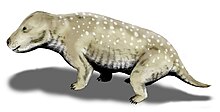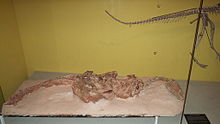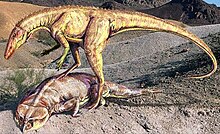Caturrita formation
The Caturrita Formation is a lithostratigraphic rock formation of sedimentary origin from the Upper Triassic of southern Brazil . It belongs to the Santa Maria supersequence (upper section) from the Rosário-do-Sul group and was deposited in the Paraná Basin .
etymology
The name of the rock formation is derived from Caturrita , a barrio ( district ) of Santa Maria in the Brazilian state of Rio Grande do Sul . Caturrita is also used in Portuguese to denote the monk parakeet (Myiopsitta monachus).
stratigraphy
The sediments of the Caturrita Formation belong to the second unit of the Santa Maria Supersequence and overlay the Alemoa member of the Santa Maria Formation , with a gradual facial transition from the clayey sediments of the Alemoa member to the sandy sediments of the Caturrita Formation takes place. The Caturrita formation ends with an erosive discordance, it then overlay the rhaetic sediments of the Mata sandstone , the third unit of the Santa Maria supersequence.
Previously, the Caturrita Formation was still regarded as a member of the stratigraphically higher Botucatu Formation or extended in its temporal extension to the hanging wall, so that it included the Mata sandstone.
The Caturrita formation reaches a maximum thickness of about 60 meters, but is usually only around 30 meters.
Age
No absolute age is available yet, but the Caturrita Formation is attributed an Upper Carnic to Noric age based on fossil finds , corresponding to about 220 to 215 million years BP.
Distribution area
The Caturrita formation is open in the southern Brazilian state of Rio Grande do Sul . It stretches in a thin band in the central part of the state over a distance of around 250 kilometers in an east-west direction from the city of Taquari to Mata .
Deposit conditions
The sediments of the Caturrita Formation form the upper portion of the second unit of the Santa Maria Supersequence. In terms of sequence stratigraphy , they are equivalent to a sea level high ( English "Highstand Systems Tract"). This is a gradual facial transition from the scarlet, predominantly clayey, ephemeral, fluviolacustrine deposits of the Alemoa member ( river meanders and oxbow lakes with alternating fine layers of clay, silt and sandstone) to an interwoven river system that is active all year round with emphasis on the sandy component. At the same time, there was a change to more humid climatic conditions.
The Caturrita Formation consists of alluvial alluvial sediments deposited under continental conditions, which are usually formed as massive sandstones and siltstones .
Fossil content
The Caturrita formation is home to an important biostratigraphic guiding zone for tetrapods , the so-called "Ictidosauria Assemblage Zone" Ca-1 . Ictidosauria are trithelodontid cynodontia , precursors or sister groups of mammals . This lead zone has recently been called the “Mammaliamorpha Cenozone” in order to emphasize the importance of the cynodontic animal finds. The Caturrita formation also contains the «Jachaleria» leading horizon, named after the Dicynodontia Jachaleria candelariensis . Dinosaurs and other vertebrates have also emerged .
The trace finds of prosauropods in 1998 at Faxinal do Soturno , an important site in the Caturrita formation, possibly caused by Unaysaurus tolentinoi, are remarkable .
The fossil finds are concentrated around three sites:
- North of Santa Maria (Água Negra)
- Faxinal do Soturno
- The surrounding area of Candelária (Linha São Luis)
The following taxa in the Caturrita formation have been discovered among the vertebrates so far:
- Cynodontia
- Dicynodontia
-
Dinosauria - Sauropoda
- Guaibasaurus candelariensis
- Sacisaurus agudoensis ? dinosaur in question
- Saturnalia tupiniquim
- Spondylosoma absconditum ? dinosaur in question
- Teyuwasu barbarenai
- Unaysaurus tolentinoi
- Dinosauria - Theropoda
-
Phytosauria
- Indeterminate taxon
- Procolophonia
- Sauropsida
- Sphenodontia
See also
Individual evidence
- ↑ Bortoluzzi, CA 1974. Contribuição à Geologia da Região de Santa Maria, Rio Grande do Sul, Brazil. Pesquisas, 4 (1): 7-86
- ^ Andreis, RR; Bossi, GE & Montardo, DK 1980. O Grupo Rosario do Sul (Triassico) no Rio grande do Sul. In: CONGRESSO BRASILEIRO DE GEOLOGIA, 31, Balneário 16 Camboriú, 1980. Anais ... Balneário de Camboriú, SBG, v. 2, pp. 659-673.
- ^ Zerfass, H .; Lavina, EL; Schultz, CL; Garcia, AJV; Faccini, UF & Chemale Jr., F. 2003. Sequence stratigraphy of continental Triassic strata of Southernmost Brazil: a contribution to Southwestern Gondwana palaeogeography and palaeoclimate. Sedimentary Geology, 161: 85-105.
- ↑ Holz, M. and Scherer, CMS, 2000, Sedimentological and paleontological evidence of paleoclimatic change during the Southbrazilian Triassic: the register of a global trend towards a humid paleoclimate: Zentralblatt für Geologie und Paläontologie, Teil I, v. 11-12, p. 1589-1609.
- ^ Rubert, RR & Schultz, CL 2004. - To novo horizonte de correlação para o Triássico Superior do Rio Grande do Sul. Pesquisas em Geociências 31: 71-88.
- ↑ Oliveira É. V. 2006. - Reevaluation of Therioherpeton cargnini Bonaparte & Barberena, 1975 (Probainognathia, Therioherpetidae) from the Upper Triassic of Brazil. Geodiversitas 28 (3): 447-465.
- ^ Soares, MB & Schultz, CL, 2006. Proposta de nova denominação para a Cenozona de Ictidosauria, do Triássico Superior (Formação Caturrita) do Rio Grande do Sul. V Simpósio Brasileiro de Paleontologia de Vertebrados, Boletim de Resumos, p. 41, Santa Maria, RS, 2006.
- ↑ Schultz. CL; Scherer, CMS & Barberena, MC 1994. Uma new proposta de zoneamento estratigráfi co para o Triássico Superior Sul-Rio-Grandense. In: Congresso Brasileiro de Geologia, 38, Camboriú - SC, 1994. Boletim de Resumos, p. 107-108.
- ↑ Rafael Costa Da Silva, Ismar De Souza Carvalho, Cibele Schwanke, 2006. Vertebrate dinoturbation from the Caturrita Formation (Late Triassic, Paraná Basin), Rio Grande do Sul State, Brazil. Gondwana Research 11 (2007) 303-310.
Web links
- The Continental Tetrapod-bearing Triassic of South Brazil (PDF file; 2.53 MB)
- Triassic tetrapods from Rio Grande do Sul (PDF file; 633 kB)




